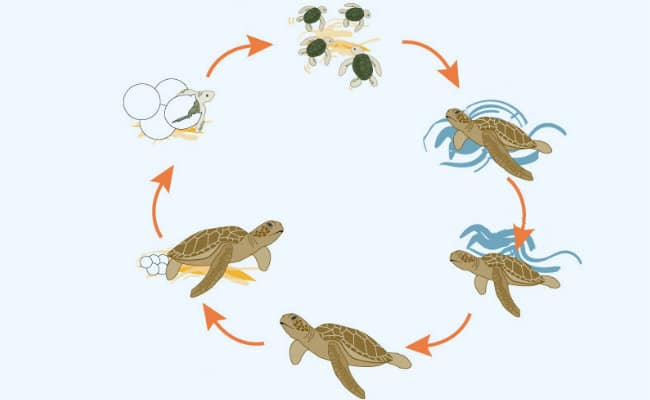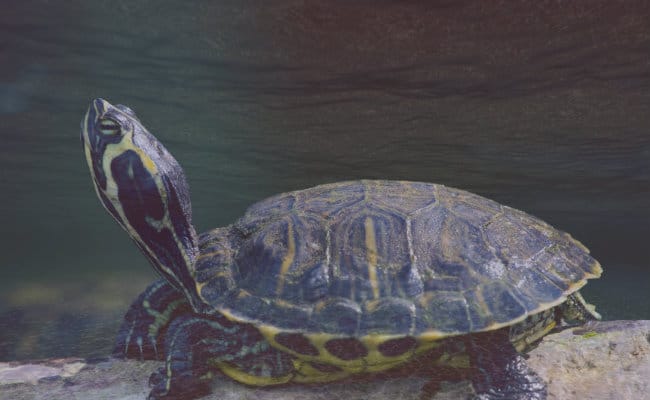The life cycle of the turtle is an object of study in many schools, because it is an animal that usually attracts the attention of children. In the same way, there are many documentaries about it on television and the Internet, which allow to know the turtles more thoroughly and to cultivate the population.
Turtles are considered one of the oldest reptiles in the world, they have a wide trunk and are surrounded by a shell that acts as a protector of the internal organs of their body. However, it manages to get its extremities: four legs, head and tail.
What is the life cycle of turtles like?

Turtles go through five periods or stages in their life cycle, among which we find nesting, breeding, growth or development, migration and reproduction. Each stage has its own characteristics and explanation, so we will detail each of them in more detail below.
1. Nesting or spawning
The cycle begins when the female turtles dig in the sand on the beach to form their nests and lay their eggs there. The process is usually carried out in the summer months, since the sand must have an optimal temperature for the growth of the hatchlings (which is why global warming affects sea turtles directly and indirectly); This temperature should range between 24 and 25 degrees.
Although it has not yet been proven, it is thought that female turtles lay their eggs in the same place where they were born; something that would make sense and that would explain how some of the turtle populations and colonies have been maintained.
As an interesting fact, turtle eggs have a protective layer, which is made up of a calcareous shell and a layer of albumin.
2. Birth of the calf and infant stage
In this life cycle of the turtle, the hatchlings that managed to overcome the incubation period will be ready to hatch, rise to the surface and head to the sea.
2.1 Rupture of the shell
To break the shell they use the caruncle that is located at the end of their beaks. The whole process can take up to three days until all the turtles have hatched, at which point the displacement begins.
2.2 Movement towards the surface
As we mentioned, once all the turtles have managed to hatch (or most), these will begin to move towards the surface. To do this, they carry out a series of movements that result in the detachment of the sand from the surface. This falls and serves in turn, as a support for the young to rise and so on until they leave the nest; where the process is usually at night to avoid the presence of predators.
However, it should be noted that depending on the temperature the process can be suspended, that is, if the temperature is high they stop making the movements; while on the contrary, they continue. Therefore, this process can also take several days.
2.3 Movement towards the sea
Once the turtles manage to surface, they head straight to the sea, where they spend an indefinite period of time swimming to get away from the coast, mainly due to predators and to reach areas where they can feed more easily.
However, these can go years or even a decade without returning to land, although many of the young turtles often explore the shores, only as a kind of “youth pastime”.

3. Development or maturity
The turtles after the swimming stage, usually are located in areas near the beaches or coasts to feed; their omnivorous diet being common. However, although it is easier to find food in these areas, they are also at greater risk from predators; This is why they normally only move to these places when they have reached a considerable size that allows them to protect themselves.
It is quite common to observe adult turtles in feeding grounds to regain energy after the spawning period; to later migrate to the mating areas.
A tortoise is considered an adult when the morphological characters denote it, which can vary according to the species. Among them are its size, weight, scales and coloration; as well as their behaviors in the different stages (reproduction, nesting, fertility or nutrition) and in the areas where they are located.
On the other hand, this marine reptile achieves the sexual maturation in a period of seven to fifteen years for tortoises in captivity and fifteen to fifty years in their habitat; although it should be noted that these periods may vary according to the species.
4. Migration
In the life cycle of the turtle there is also a migration stage, in which each population has its own areas of nutrition and reproduction. Despite this, he still does not know if females and males migrate at the same time.
Mainly, the turtles go to the nutrition area to ingest food and thus obtain the necessary energy. Subsequently, these are move to playback areas, which can be thousands of miles apart.
5. Reproduction
Once they have migrated to the mating areas, reproduction begins, where the female mates with a male so that he can fertilize her eggs. However, in some species of turtles multiple matings have been observed, so there will be eggs from different parents.
El reproduction period of turtles it is repeated annually in the summer season (some species are biannual or triannual), where the females, once they have finished the reproduction period, travel to the coasts to begin the nesting process.
The life cycle of these incredible and special animals has finally concluded, which we must take care of and protect to avoid their extinction. Share the article with your friends and make them discover how wonderful turtles are!